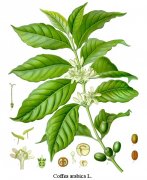Coffee bean harvesting and processing Fine coffee bean processing
Every winter (dry season) is the harvest time for coffee beans. After three to four years of growth, coffee trees mature and begin to bear fruit. The fruits are arranged in a string or clustered together next to the branches. Coffee beans are wrapped in red skins and can be picked as soon as they turn red.

Most Arabica coffee beans mature from June to August and Roberts coffee beans from September to October. Therefore, although in some countries where the dry and wet seasons are not obvious, such as Colombia and Kenya, there are two flowering periods a year, that is, two harvests, strictly speaking, only once a year.
Of course, the harvest time varies from region to region. To the south of the equator, such as Brazil and Zimbabwe, the main harvest is in April or May, but it lasts until August. Regions north of the equator (such as Ethiopia and Central America) are generally harvested in September-November. However, equatorial countries, such as Uganda and Colombia, can harvest all year round, especially those plantations that make good use of different elevations. As a result, there may be new coffee beans for most of the year.
As far as picking coffee beans is concerned, there are two ways. One is picking in pieces, that is, picking all the beans in the garden at once, and the other is picking selectively, that is, picking only the ripe red berries at intervals of 8-10 days, so you need to pick more times in the yard. Compared with the former method, the latter method is labor-intensive and expensive, and is generally used only for Arabica coffee beans, especially those that need to be washed.
The number of coffee beans picked depends on a variety of factors, the most obvious being the height of the trees and the layout of the farm or plantation. On average, the average farm picker can pick 50-100 kilograms a day. However, only 20% of these coffee beans are real coffee beans, so each picker can only pick 10-20 kilograms of coffee beans on average. Coffee beans are packed in bags with a standard mass of 45-60 kilograms. As a result, it takes 3-6 days for a worker to fill a bag.
It has been calculated that the cost of harvesting a plantation or farm is half of the total cost of the year. In Brazil, people have tried many times to use mechanical picking to reduce these costs. The machine shakes branches across the coffee tree so that berries that become loose because they are ripe will fall into the funnel star. But this can only be done in places where natural conditions are better, and they need to be high-speed in advance, because the machine can only be used where the trees can be planted in rows and rows, and the coffee beans picked by the machine need to be checked afterwards to pick out the leaves and branches that have fallen in the funnel. It is troublesome to pick in this way.
In areas with relatively high elevations, such mechanical picking method cannot be adopted, and manual picking must be used, which requires a large number of seasonal workers. Pickers should also be careful not to pick unripe, bad or overripe coffee beans, as they will affect the overall quality of the coffee harvested. The original picking method ensures the quality of coffee bean picking to a great extent. Those coffee beans that are not so good are classified as "ordinary", "sour" or "fermented", and the last one is very bad.
Important Notice :
前街咖啡 FrontStreet Coffee has moved to new addredd:
FrontStreet Coffee Address: 315,Donghua East Road,GuangZhou
Tel:020 38364473
- Prev

The way coffee is grown.
Coffee cultivation is now widely grown in the ribbon between the Tropic of Cancer and the Tropic of Cancer. Coffee grown in different regions has different flavors. The unique soil, climatic conditions and planting methods of a country make the coffee produced in that country have a unique flavor. French winemakers call this phenomenon regional style. Geographically, global coffee
- Next

Coffee cultivation techniques detailed explanation of planting knowledge of Coffee trees
Coffee, cocoa and tea are called the three major beverages in the world, and their output, consumption and output value all rank first. In addition to being used as a beverage, coffee can also extract caffeine and coffee oil; in medicine, it can be used as an anesthetic, stimulant and diuretic cardiotonic agent. Coffee pulp can be used to make wine, vinegar, pectin and molasses; dried pulp can be used as animal feed; dried fruit shell can be used as fertilizer and burning
Related
- Beginners will see the "Coffee pull flower" guide!
- What is the difference between ice blog purified milk and ordinary milk coffee?
- Why is the Philippines the largest producer of crops in Liberia?
- For coffee extraction, should the fine powder be retained?
- How does extracted espresso fill pressed powder? How much strength does it take to press the powder?
- How to make jasmine cold extract coffee? Is the jasmine + latte good?
- Will this little toy really make the coffee taste better? How does Lily Drip affect coffee extraction?
- Will the action of slapping the filter cup also affect coffee extraction?
- What's the difference between powder-to-water ratio and powder-to-liquid ratio?
- What is the Ethiopian local species? What does it have to do with Heirloom native species?

